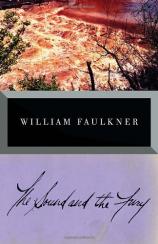About the Book
About the Book
The Sound and the Fury

The Sound and the Fury, published in October of 1929, was Faulkner's fourth novel--and clearly his first work of genius. Now considered to be one of the strongest American contributions to the fiction of high modernism, it has generated countless critical interpretations. In writing the novel, Faulkner experienced a creative absorption and passion that he was never to forget; he said of The Sound and the Fury, "It's the book I feel tenderest towards. I couldn't leave it alone, and I never could tell it right, though I tried hard and would like to try again, though I'd probably fail again."
The novel tells the story, from four different perspectives, of the disintegration of a Southern family. The father is cynical and passive, and though he clearly loves his children, he drinks himself to death; the invalid mother has no love for her children and continuously demands that she herself be taken care of; Benjy, the mentally retarded son of whom his mother is ashamed, is castrated after he begins to exhibit sexual behavior; Quentin, the neurotic and romantic son, goes off to Harvard to fulfill his mother's lifelong wish and commits suicide there; Caddy, the only daughter, becomes pregnant while still a teenager and quickly marries a man who turns her out of the house when he discovers that their child is not his; Jason, his mother's favorite, loses his chance at a lucrative job when Caddy's marriage fails and is reduced to supporting the family by working in a general store. Caddy's daughter--named after her brother Quentin--is brought up in the unhappy Compson household although everyone is forbidden to speak her mother's name. She has her revenge upon her uncle Jason when she steals the $7000 he has amassed by embezzling from his mother and from funds sent to Quentin by Caddy. The family is supported and cared for by a family of black servants, led and held together by the matriarch Dilsey.
Because of its experimental style, The Sound and the Fury presents a daunting challenge for readers. By 1929 Faulkner had given up trying to please publishers and reviewers, and, as the critic Albert J. Guerard has noted, now seemed "to write only for himself and a happy few." Traditional aspects of the novel like exposition, plot, and character development are cast aside in the attempt to find a narrative form that could represent the realities of mental chaos, the fluidity of time and memory, and the painful interweaving of separate selves in family life. Though at times Faulkner's material may seem so inchoate as to be barely containable within language at all, The Sound and the Fury attains heights and depths of expression that are truly breathtaking: it is an unforgettable work that richly rewards the reader's efforts.



